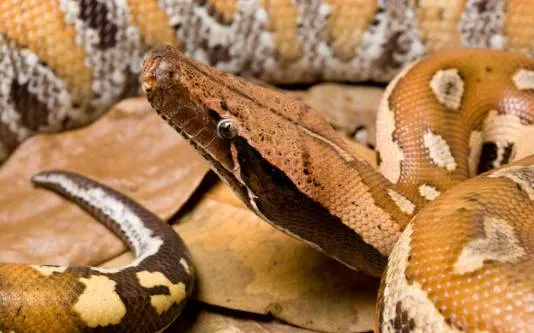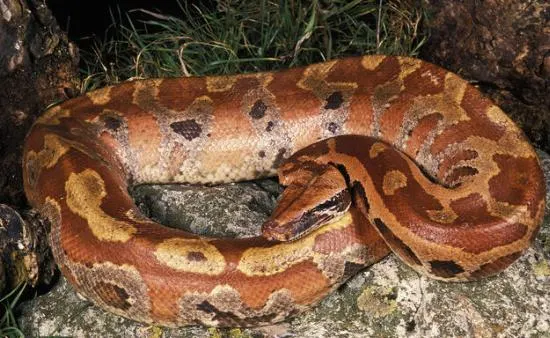The Blood Python (Python brongersmai) is a fascinating reptile known for its striking appearance and unique behavior. This medium-sized, non-venomous snake is native to Southeast Asia and has garnered attention both as a captivating pet and as a subject of scientific interest. In this blog post, we will delve into the world of the Blood Python, exploring its physical characteristics, habitat, behavior, and care requirements. We will also address some frequently asked questions to provide a thorough understanding of this remarkable snake.

Table of Contents
Physical Characteristics
The Blood Python is renowned for its vivid coloration and robust build. These snakes can grow up to 8 feet in length, with females generally being larger than males. Their most distinctive feature is the blood-red markings on their skin, which range from bright oranges and reds to reddish-brown hues. Alongside these striking colors, Blood Pythons often exhibit tan to yellow stripes or blotches running the length of their bodies, accompanied by brown and black spots on the sides and back. The head of the Blood Python is marked with a dark brown “V” shape blotch and a line down the center, adding to its distinctive appearance.
Habitat and Distribution
Blood Pythons are primarily found in Southeast Asia, including Thailand, the Malay Peninsula, Sumatra, and various smaller islands in the region. They thrive in a variety of habitats, including tropical forests, swamps, marshes, and palm plantations. These ground-dwelling predators are known for their patience, often lying still for hours on the forest floor while waiting for prey to approach. Their nocturnal and shy nature means they are mostly solitary, interacting only during the mating season.
Behavior and Diet
Blood Pythons are crepuscular, meaning they are most active during dawn and dusk. They are solitary creatures, except during mating season, and are known for their calm demeanor when their basic needs are met. Despite their fearsome reputation, largely due to early interactions with humans, Blood Pythons are generally non-aggressive and will often flee rather than fight when threatened.
These snakes are carnivorous, primarily feeding on rats, mice, and other small mammals. They use constriction to subdue their prey, wrapping their muscular bodies around the victim and squeezing until it suffocates. Blood Pythons have a slow metabolic rate, so they do not need to eat frequently; adults typically consume a large rat every three weeks, while younger snakes may need to eat every 10 to 14 days.
Conservation Status
The Blood Python is currently listed as “Least Concern” on the IUCN Red List. Despite facing threats from habitat destruction and the pet trade, their populations are believed to be stable and even increasing in some areas. This resilience is partly due to their adaptability to human-modified environments, such as palm oil plantations, which provide abundant
Keeping Blood Pythons as Pets
Blood Pythons have become popular pets due to their manageable size and striking appearance. However, they require specific care to thrive in captivity. Here are some essential tips for keeping Blood Pythons as pets:
- Housing: Blood Pythons prefer enclosures with opaque walls to create a sense of security. Tubs are often recommended for their ease of maintenance and ability to provide a controlled environment. For adults, a
tank size of at least 48 x 24 inches is ideal. - Temperature and Humidity: Maintaining the right temperature is crucial. Blood Pythons prefer ambient temperatures between 78–82°F, with a cooler side and a warmer basking spot. Humidity should be kept around 60%, which can be achieved with a thick layer of damp moss and a large water bowl.
- Lighting: These snakes are naturally reclusive and thrive in low-light conditions. If using artificial lighting, ensure it is turned off at night to maintain a natural day/night cycle.
- Diet: Feed Blood Pythons infrequently due to their slow metabolism. Provide a large rat every three weeks for adults, and adjust the frequency for younger snakes as needed.
- Handling: Allow new Blood Pythons to acclimate for at least three to four weeks before handling. Gradual and gentle handling will help build trust and reduce stress.
Frequently Asked Questions (FAQs)
Q: Are Blood Pythons venomous?
A: No, Blood Pythons are non-venomous. While their bite can cause significant damage due to their strong jaws, they do not possess venom that is harmful to humans.
Q: How do Blood Pythons hunt?
A: Blood Pythons are ambush predators. They remain still for extended periods, waiting for prey to come within striking distance. Once the prey is close enough, they strike quickly and use constriction to subdue it.
Q: Are Blood Pythons aggressive?
A: Blood Pythons have a reputation for aggression, but this is often due to improper care or handling. When their basic needs are met, they are generally calm and can become quite docile with proper care.

Q: What do Blood Pythons eat?
A: Blood Pythons primarily feed on small mammals such as rats and mice. They occasionally consume birds as well. In captivity, a diet of appropriately sized rodents is recommended.
Q: Do Blood Pythons make good pets?
A: Captive-bred Blood Pythons can make excellent pets for experienced snake keepers. They are relatively easy to handle and can become quite affectionate. However, wild-caught specimens may not adapt well to captivity and can be more challenging to care for.
Q: How long do Blood Pythons live?
A: With proper care, Blood Pythons can live up to 25 years in captivity. Providing the right environment, diet, and handling will contribute to their longevity.
Q: What is the price of a Blood Python?
A: The price of a Blood Python can vary widely depending on factors such as coloration and morph. Basic specimens may start around $100, while rarer morphs can cost several thousand dollars.
In conclusion, the Blood Python is a captivating and unique species that offers both beauty and intrigue. Whether you are a seasoned herpetoculturist or a curious enthusiast, understanding the needs and behaviors of this snake is essential for its proper care and appreciation. By providing the right environment and care, Blood Pythons can thrive in captivity and become fascinating companions for those willing to invest the time and effort in their care.
- Enchi Ball Python: A Unique and Stunning Morph of Python regius - March 27, 2025
- Emerald Tree Monitor: The Enigmatic Green Guardian of the Rainforest - March 26, 2025
- The Egyptian Cobra (Naja haje): A Fascinating Serpent - March 25, 2025
